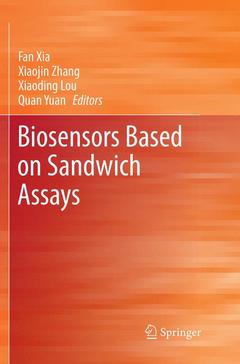Description
Biosensors Based on Sandwich Assays, Softcover reprint of the original 1st ed. 2018
Coordinators: Xia Fan, Zhang Xiaojin, Lou Xiaoding, Yuan Quan
Language: English
Subject for Biosensors Based on Sandwich Assays:
Publication date: 01-2019
Support: Print on demand
Publication date: 03-2018
216 p. · 15.5x23.5 cm · Hardback
Description
/li>Contents
/li>Biography
/li>Comment
/li>
This book shows the various sandwich assays that are constructed from recognition molecules, such as antibodies, oligonucleotide sequences and aptamers, developed as a result of nano- and biotechnology advances. It consists of ten chapters presenting interesting examples of these assays, organized according to the type of analytic methods (colorimetric, fluorescence, electrochemical, etc.) and detected objects (protein, nucleic acid, small-molecule, ion, etc.). It also includes a chapter discussing the introduction of sandwich assays as biosensors for the detection of a range of targets. It is an interesting and useful resource for a wide readership in various fields of chemical science and nanotechnology.
Introduction.- Colorimetric Sandwich Assays for Protein Detection.- Fluorescence Sandwich Assays for Protein Detection.- Electrochemical Sandwich Assays for Protein Detection.- Sandwich Assays Based on SPR, SERS, GMR, QCM, Microcantilever, SAW, and RRS Techniques for Protein Detection.- Colorimetric Sandwich Assays for Nucleic Acid Detection.- Fluorescence Sandwich Assays for Nucleic Acid Detection.- Electrochemical Sandwich Assays for Nucleic Acid Detection.- Sandwich Assays Based on QCM, SPR, Microcantilever, and SERS Techniques for Nucleic Acid Detection.- Sandwich Assays for Small Molecule and Ion Detection.- Sandwich Assay for Pathogen and Cells Detection.- Biosensors Based on Supersandwich Assays.
Fan Xia is currently a professor at Huazhong University of Science and Technology (HUST) and Dean of the Faculty of Materials Science and Chemistry, China University of Geosciences (Wuhan). He received his BSc degree (2003) from HUST and PhD degree (2008) from the Institute of Chemistry, Chinese Academy of Sciences (ICCAS) (Lei Jiang’s group). He then worked as a postdoctoral fellow in Prof. Alan J. Heeger’s group at the University of California, Santa Barbara. He joined HUST as part of the 1000 Young Talents Program in 2012. His scientific interest focuses on bio-analytical chemistry.
Xiaojin Zhang is currently a professor at China University of Geosciences (Wuhan). He received his BSc (2007) and PhD degrees (2012) from Wuhan University (Renxi Zhuo’s group). He then worked as a postdoctoral fellow in Prof. Peter X. Ma’s group at the University of Michigan, Ann Arbor. He joined China University of Geosciences (Wuhan) in 2016. His scientific interests focus on nanomaterials for theranostics.
Xiaoding Lou is currently a professor at China University of Geosciences (Wuhan). She received her PhD degree (2012) from Wuhan University (Zhen Li’s group). She then worked as a research associate in Prof. Ben Zhong Tang’s group at the Hong Kong University of Science and Technology. She joined China University of Geosciences (Wuhan) in 2017. Her scientific interests focus on the chemical and biosensor field.
Quan Yuan is currently a professor at Wuhan University. She received her BSc degree (2004) from Wuhan University and PhD degree (2009) from Peking University (Chunhua Yan’s group). She then worked as a postdoctoral fellow in Prof. Weihong Tan’s group at the University of Florida. She joined Wuhan University in 2011. Her scientific interests focus on upconversion nanoparticles and DNA nanotechnology.




